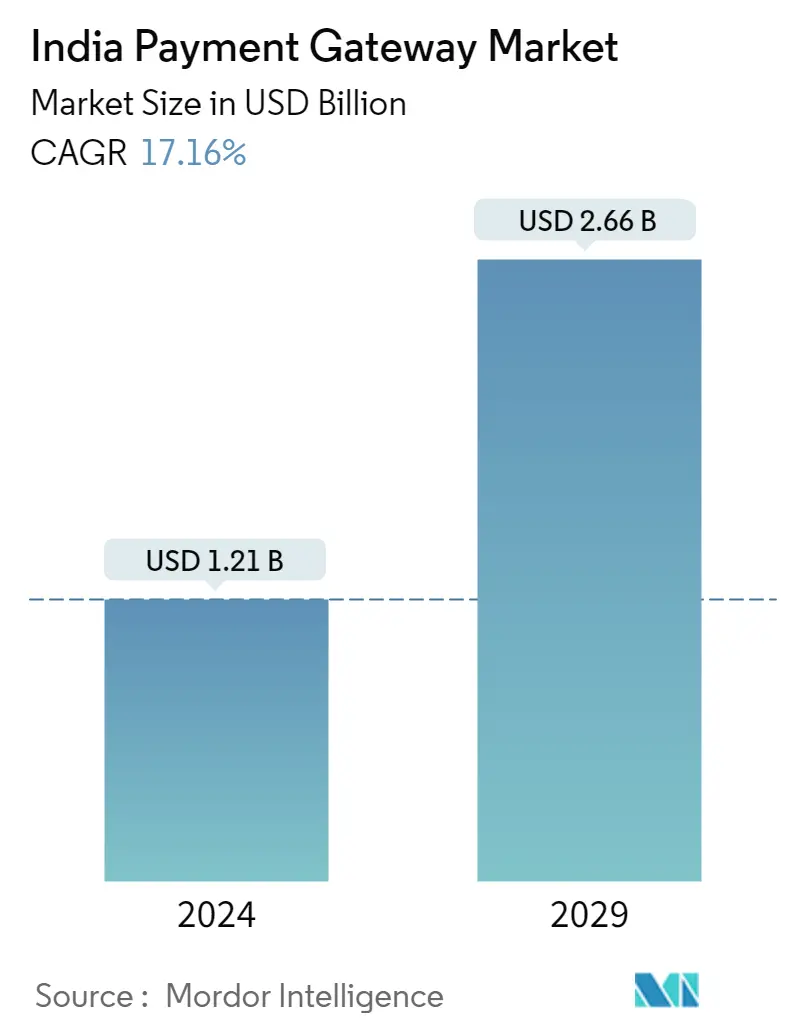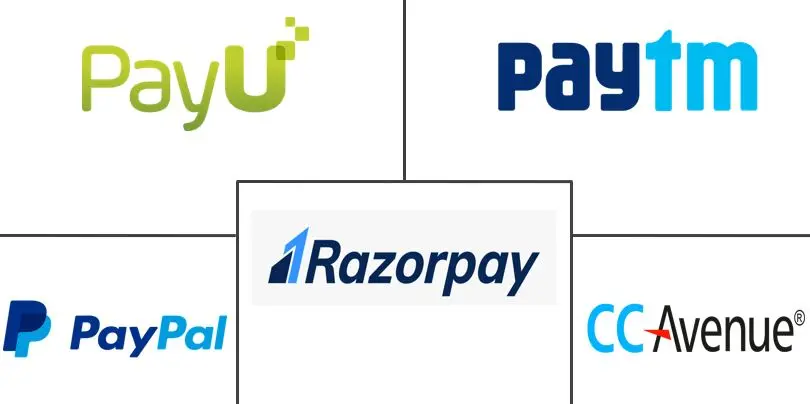Market Size of India Payment Gateway Industry

| Study Period | 2019 - 2029 |
| Base Year For Estimation | 2023 |
| Market Size (2024) | USD 1.21 Billion |
| Market Size (2029) | USD 2.66 Billion |
| CAGR (2024 - 2029) | 17.16 % |
| Market Concentration | Low |
Major Players
*Disclaimer: Major Players sorted in no particular order |
India Payment Gateway Market Analysis
The India Payment Gateway Market size is estimated at USD 1.21 billion in 2024, and is expected to reach USD 2.66 billion by 2029, growing at a CAGR of 17.16% during the forecast period (2024-2029).
Integrating a payment gateway has become one of the most critical aspects of any business in every industry. It allows collecting money through the customer's preferred bank without compromising sensitive data.
- With the increasing internet penetration and awareness about the ease of online transactions, consumers are changing their preferences for making payments online. The hurdle-free transactions generate confidence among the users for switching to online transactions. This rapid adoption of the online payment method is fueling India's payment gateway market growth.
- Digital payment has been one of the highlights of the government's 'Digital India' initiative, and online payment platforms and services have spread themselves in the country. Post demonetization, digital transactions witnessed a tremendous increase, which led to the sudden emergence of payment gateway vendors.
- The payment gateway market in India is boosted by an increase in digital payment trends in India. Government initiatives are helping enhance the digital payment space and emphasize moving toward a cashless economy. For instance, the Digital India program is a flagship program of the Government of India with a vision to transform India into a digitally empowered society.
- As per Worldline, asset-lite technologies will emerge and establish merchant acquiring in the near future. Asset-lite refers to the acceptance of all forms of digital payments, including cards, not on traditional POS machines but merchants' mobile phones. On this technology platform, merchants using an app on their phones will be able to accept payments through QR and cards. This will further increase the adoption of digital costs all over India.
- Although the awareness and adoption of digital payments are increasing, the digital infrastructure needs to be strengthened further to ensure consistent reach and penetration across the Tier 2 and Tier 3 cities and rural areas. Small merchants need acceptance tools that are cost-effective and easy to enable. In many cases, it is difficult for a micro-merchant to keep tabs on different means such as wallets, UPI, and bank apps.
- Smaller cities and towns have been at the forefront of digital payments and transactions recovery amid the pandemic. According to the National Payments Corporation of India, Unified Payments Interface (UPI), transactions will see a boost due to the outbreak of Covid-19. The umbrella organization for operating retail payments and settlement systems in India said that the relevance of UPI would grow in the 'physical' world, combining the physical and digital space, in a post-COVID world.
India Payment Gateway Industry Segmentation
The India Payment Gateway Market is segmented by Organization Size (Small and Medium, and Large-scale). The study tracks the current market scenario and the key developments in the Payment Gateway Market in India.
| By Organization Size | |
| Small and Medium | |
| Large-Scale |
India Payment Gateway Market Size Summary
The India Payment Gateway Market is experiencing significant growth, driven by the increasing adoption of digital payment methods and the government's push towards a cashless economy through initiatives like Digital India. The integration of payment gateways has become essential for businesses across various sectors, enabling secure transactions through customers' preferred banking options. The rise in internet penetration and the growing comfort with online transactions are key factors propelling the market forward. The post-demonetization era saw a surge in digital transactions, leading to the emergence of numerous payment gateway vendors. The market is further bolstered by advancements in asset-lite technologies, which allow merchants to accept digital payments via mobile phones, enhancing the reach of digital payment solutions across the country.
The competitive landscape of the India Payment Gateway Market is marked by the presence of both small and large players, including major companies like PayU, Paytm, Razorpay, and PayPal India. These companies are expanding their market share through strategic partnerships, investments, and product launches. Regulatory support from the Reserve Bank of India, such as guidelines on Payment Aggregators and the exemption of Merchant Discount Rate charges on UPI transactions, is also contributing to market growth. The e-commerce sector's expansion, fueled by government regulations allowing 100% FDI in B2B e-commerce, is further driving the adoption of payment gateways. The market's growth is supported by the increasing use of UPI and card transactions, as well as the entry of new vendors in the e-commerce space, which collectively enhance the digital payment ecosystem in India.
India Payment Gateway Market Size - Table of Contents
-
1. MARKET INSIGHTS
-
1.1 Market Overview
-
1.2 Industry Attractiveness - Porter's Five Forces Analysis
-
1.2.1 Bargaining Power of Suppliers
-
1.2.2 Bargaining Power of Consumers
-
1.2.3 Threat of New Entrants
-
1.2.4 Threat of Substitutes
-
1.2.5 Intensity of Competitive Rivalry
-
-
1.3 Impact of COVID-19 on the India Payment Gateway Market
-
-
2. MARKET SEGMENTATION
-
2.1 By Organization Size
-
2.1.1 Small and Medium
-
2.1.2 Large-Scale
-
-
India Payment Gateway Market Size FAQs
How big is the India Payment Gateway Market?
The India Payment Gateway Market size is expected to reach USD 1.21 billion in 2024 and grow at a CAGR of 17.16% to reach USD 2.66 billion by 2029.
What is the current India Payment Gateway Market size?
In 2024, the India Payment Gateway Market size is expected to reach USD 1.21 billion.

